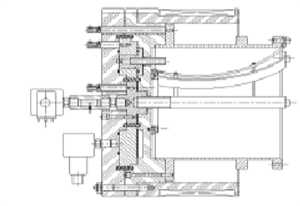
Magneto-plasma-dynamic thrusters (MPD) are currently under investigation as possible high-power electric propulsion for space missions. At high power, critical regimes are observed. This limits the performance of the thruster. Experimental investigations show that, beyond a critical value, fluctuations in the discharge voltage occur. Simultaneously, the anode losses increase and lead to a strong decrease of the efficiency. The point at which this unstable behaviour starts is referred as “onset”. The plasma engineering laboratory, in the task of a multi-institute research project, focused the attention on the measurements of emitted radiation by plasma and determination of its temperature.
The experimental apparatus is an axisymmetric MPD thruster with an external magnetic field. The thruster has been developed at Centrospazio. It consists of a hollow cathode (copper, 20 mm diameter, 50 mm length) lying on the thruster axis, through which 70-90% of a gaseous propellant is injected into the discharge chamber, and an anode, consisting of a cylinder centered on the axis (aluminum, 200 mm inner diameter, 180 mm length). Eight straps, made of copper, divide a central chamber from a peripheral chamber. 10-30% of the propellant is injected through eight peripheral hollow electrodes (copper, 12 mm in diameter each). These
|
 |
In the animation is shown the function principle of an MPD thruster. The current flowing has got the double aim of ionising the gas (Argon in our experiment) and creating the induction field that accelerate the charged particles by means of the Lorenz interaction. A variation of this scheme can iclude an additional azimutal field.
The optical diagnostic consists of a optical multi-channel analyzer (OMA) Mechelle ä 900 system, which is a spectrograph coupled with a CCD camera. A collector has been connected to the OMA through a fibre-optic. The system can be trigged from an external trigger source. The wavelength range simultaneously recorded by OMA is 200-1100 nm with a constant spectral resolution ( l / D l = 900, where l is actual wavelength and D l the wavelength resolution). The collector was placed out of the vacuum chamber and inside the plasma plume, by means of an appropriate probe. This diagnostic equipement was tested and calibrated in the Argon discharge chamber of Bologna before any experimental campaign at Pisa.
Go to the MPD thruster gallery or to the discharge chamber gallery